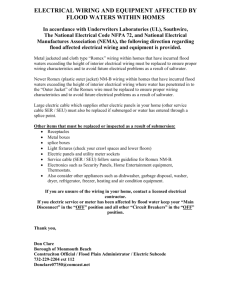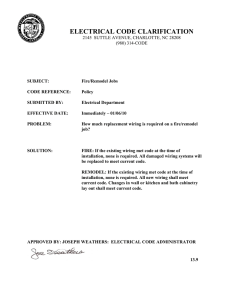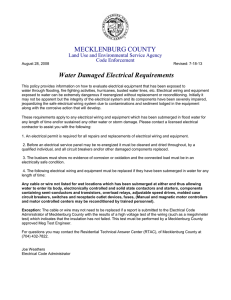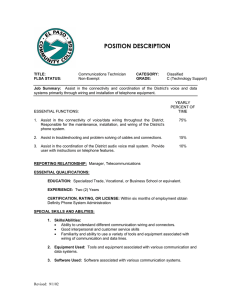Electrical Safety and Water Damaged Electrical Equipment
advertisement
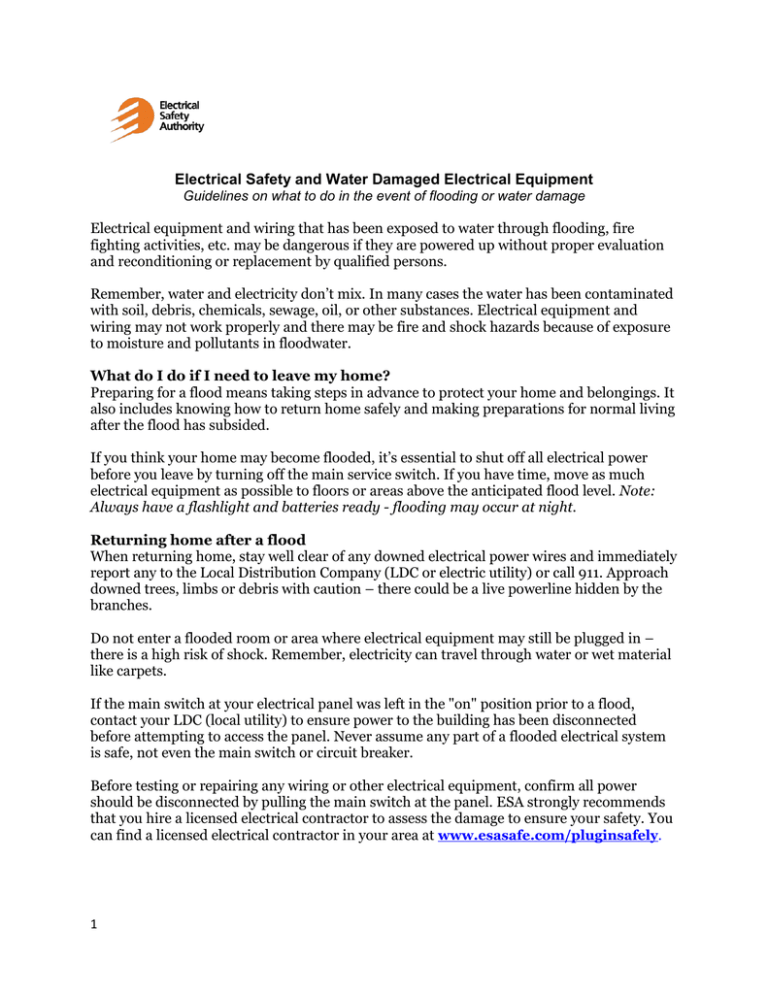
Electrical Safety and Water Damaged Electrical Equipment Guidelines on what to do in the event of flooding or water damage Electrical equipment and wiring that has been exposed to water through flooding, fire fighting activities, etc. may be dangerous if they are powered up without proper evaluation and reconditioning or replacement by qualified persons. Remember, water and electricity don’t mix. In many cases the water has been contaminated with soil, debris, chemicals, sewage, oil, or other substances. Electrical equipment and wiring may not work properly and there may be fire and shock hazards because of exposure to moisture and pollutants in floodwater. What do I do if I need to leave my home? Preparing for a flood means taking steps in advance to protect your home and belongings. It also includes knowing how to return home safely and making preparations for normal living after the flood has subsided. If you think your home may become flooded, it’s essential to shut off all electrical power before you leave by turning off the main service switch. If you have time, move as much electrical equipment as possible to floors or areas above the anticipated flood level. Note: Always have a flashlight and batteries ready - flooding may occur at night. Returning home after a flood When returning home, stay well clear of any downed electrical power wires and immediately report any to the Local Distribution Company (LDC or electric utility) or call 911. Approach downed trees, limbs or debris with caution – there could be a live powerline hidden by the branches. Do not enter a flooded room or area where electrical equipment may still be plugged in – there is a high risk of shock. Remember, electricity can travel through water or wet material like carpets. If the main switch at your electrical panel was left in the "on" position prior to a flood, contact your LDC (local utility) to ensure power to the building has been disconnected before attempting to access the panel. Never assume any part of a flooded electrical system is safe, not even the main switch or circuit breaker. Before testing or repairing any wiring or other electrical equipment, confirm all power should be disconnected by pulling the main switch at the panel. ESA strongly recommends that you hire a licensed electrical contractor to assess the damage to ensure your safety. You can find a licensed electrical contractor in your area at www.esasafe.com/pluginsafely. 1 Getting reconnected If electrical power to your home has been disconnected because of safety concerns or damage to your home’s electrical system, your local utility requires written authorization from the Electrical Safety Authority before they can reconnect power to your home. An ESA permit is required and an ESA inspector will ensure repairs or replacement of wiring and equipment have been completed correctly before authorizing the utility to reconnect your electrical service. Further information regarding this process or to locate a licensed electrical contractor may be obtained from the Electrical Safety Authority at 1-877ESA-SAFE (372-7233) or at www.esasafe.com. Safety tips for cleaning up damp or wet locations Water and electricity don’t mix. To reduce the risk of shock from using electrical appliances in wet locations, ensure your wet/dry vacuum or other equipment is plugged into an outlet that uses a ground fault circuit interrupter (GFCI). Look for power bars that are equipped with GFCIs that can be used on a temporary basis during clean-up. Reconditioning flood or water damaged equipment Do not plug in or attempt to use electrical appliances that have been wet until they have been serviced by an electrician or service agency. There may be internal damage that you can’t see. Certain electrical equipment that has been submerged may have to be replaced, while other equipment could be serviced by qualified personnel. Ask your electrician or contact the manufacturer or dealer to find the nearest service location. All breakers, fuses, disconnect switches, GFCIs, Arc Fault Circuit Interrupters, and surge protective devices that have been submerged must be replaced. There is no method of insuring these life safety devices will operate as intended when they are exposed to water; All electrical equipment, panels, switchgear, motor control centers, boilers and boiler controls, electric motors, transformers, receptacles, switches, light fixtures, electric heaters and appliances such as water heaters, ovens, ranges, and dishwashers that have been submerged need to be replaced or repaired by the original manufacturer or an approved representative; and Electrical wiring may require replacement depending on the type of wire or cable and the extent of the damage. Assessing damage to electrical equipment is a job best left to the experts. In many cases replacing the affected wiring and equipment is the only safe alternative, even if there’s no visible damage. Simply allowing equipment and wiring to “dry out” and then powering the device up is not recommended. Always work with qualified experts -- using improper cleaning agents and techniques could lead to serious safety hazards. ESA recommends that you hire a licensed electrical contractor knowledgeable in this type of work to evaluate and repair or replace water-damaged electrical equipment and wiring. Electrical equipment or components that have been replaced due to water damage should be destroyed and must not be re-used. 2 All repair or replacement of electrical wiring and equipment is subject to inspection requirements according to the Ontario Electrical Safety Code; a licensed electrical contractor will look after this. For more information, contact ESA at 1-877-ESA-SAFE (372-7233). Additional considerations for homeowners Remove dangerous chemicals such as weed killers, insecticides and corrosives to dry areas to reduce the chance of contaminating electrical equipment. Shut off all electrical power and the gas supply valve to any gas-fired appliance prior to flooding, if possible. Shut off the electrical supply to all oil-fired equipment. For additional fuel safety tips contact the Technical Standards and Safety Authority at http://www.tssa.org/. For more information For assistance regarding other aspects of electrical safety or for further information about electrical safety in a flood situation, call 1-877-ESA-SAFE or visit www.esasafe.com. 3
